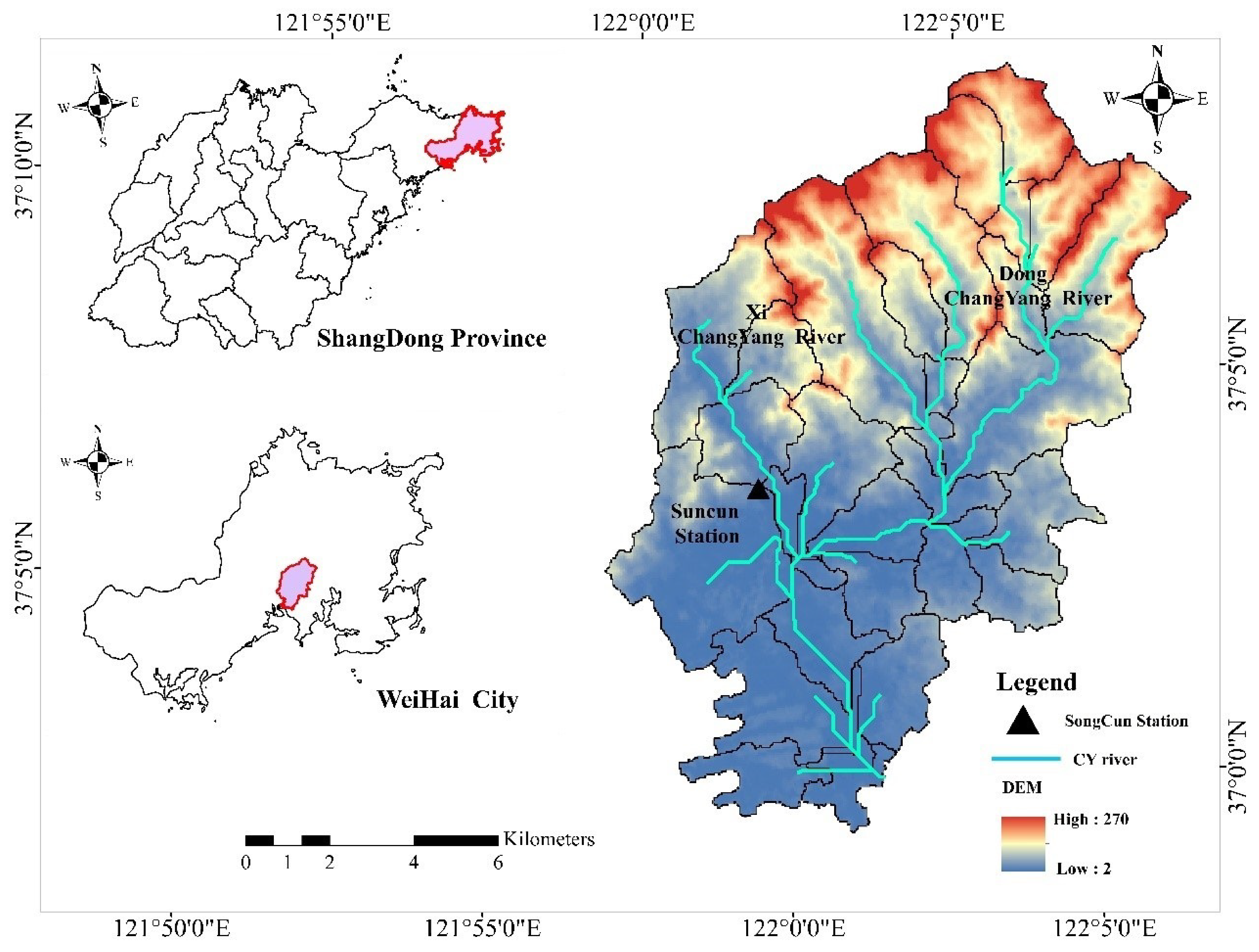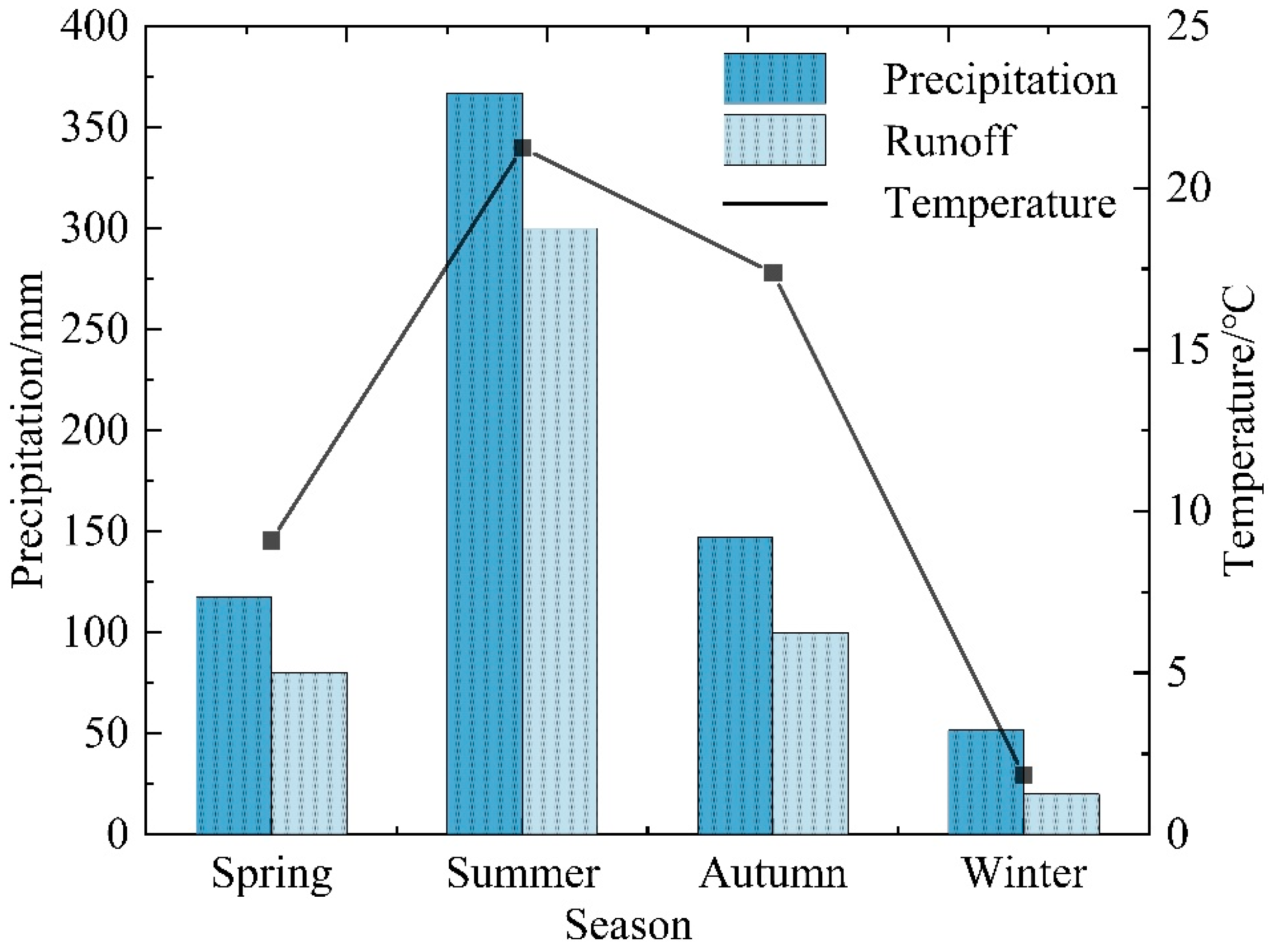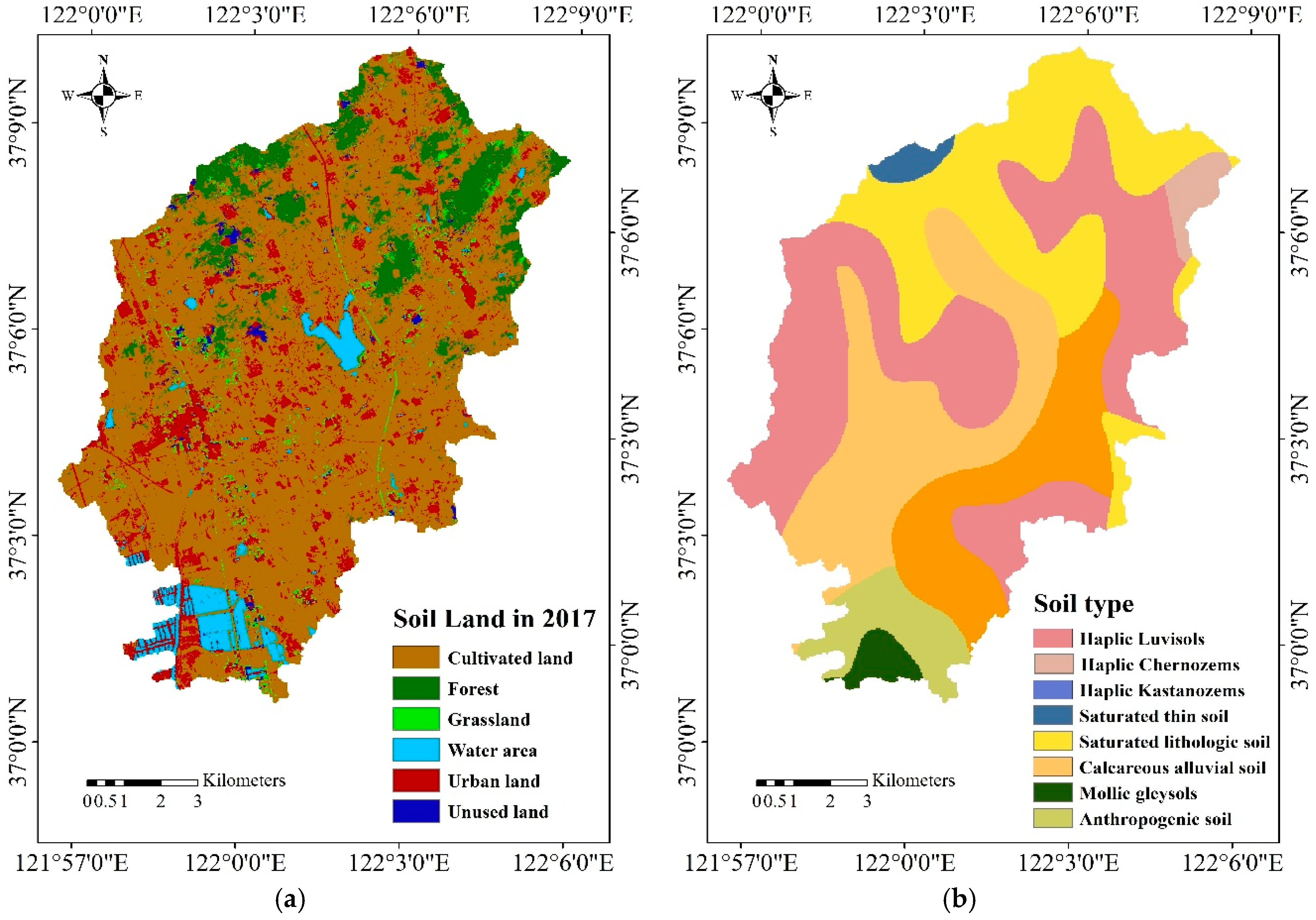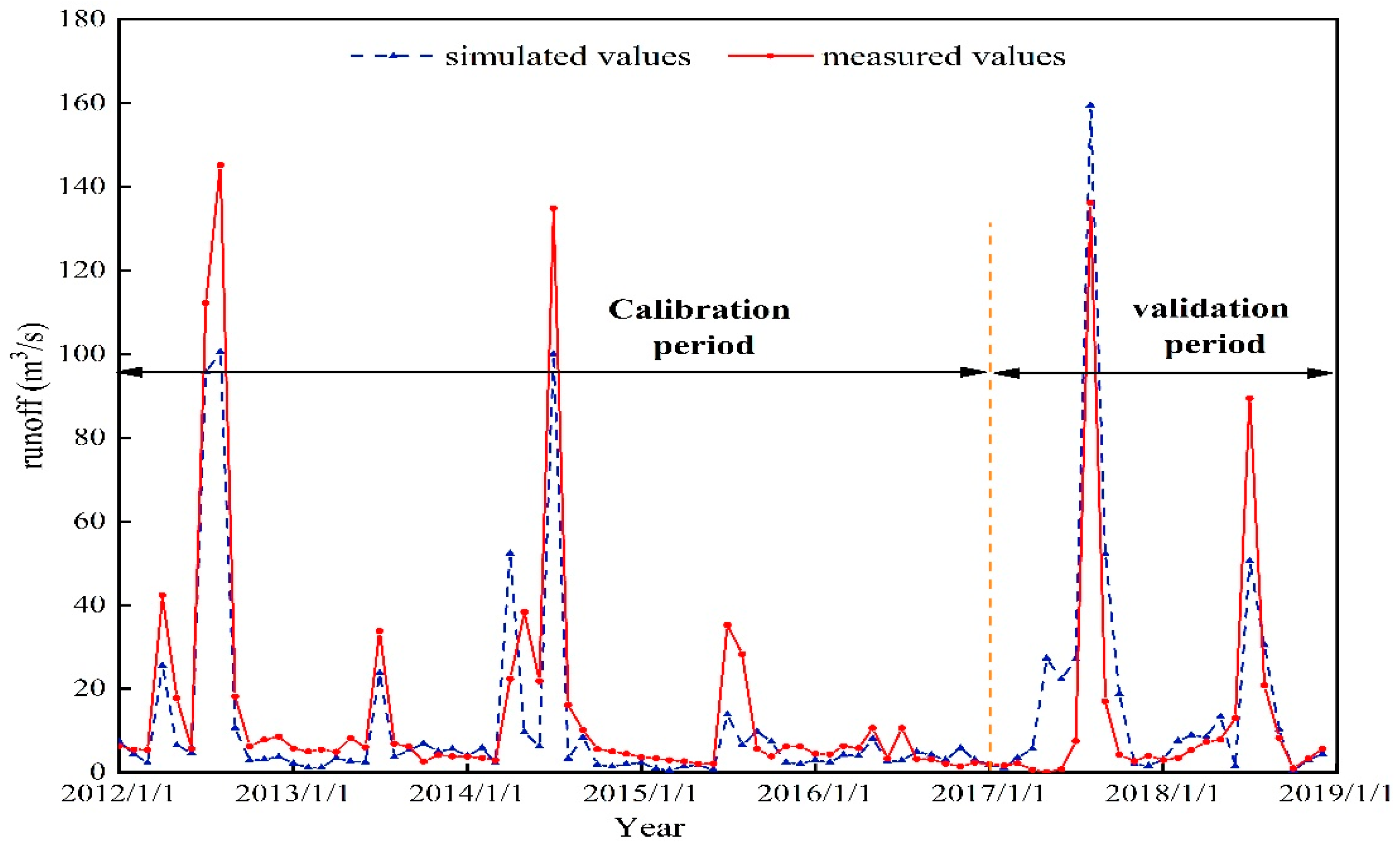The Assessment of Climate Change and Land-Use Influences on the Runoff of a Typical Coastal Basin in Northern China
Abstract
1. Introduction
2. Materials and Methods
2.1. Study Region
2.2. Data Sources
2.3. SWAT Model
2.4. Calibration and Validation of the SWAT Model
2.5. Scenario Settings
3. Results
3.1. Model Calibration and Validation
3.2. Contribution of Land Use and Climate Change to Runoff Variation
3.3. Scenario Analysis of Land Use
3.4. Scenario Analysis of Climate Change
4. Discussion
5. Conclusions
Author Contributions
Funding
Conflicts of Interest
References
- Barnett, T.P.; Adam, J.C.; Lettenmaier, D.P. Potential impacts of a warming climate on water availability in snow-dominated regions. Nature 2005, 438, 303–309. [Google Scholar] [CrossRef] [PubMed]
- Yao, J.; Wang, G.; Xue, W.; Yao, Z.; Xue, B. Assessing the Adaptability of Water Resources System in Shandong Province, China, Using a Novel Comprehensive Co-evolution Model. Water Resour. Manag. 2019, 33, 657–675. [Google Scholar] [CrossRef]
- Iqbal, Z.; Shahid, S.; Ahmed, K.; Ismail, T.; Khan, N.; Virk, Z.T.; Johar, W. Evaluation of global climate models for precipitation projection in sub-Himalaya region of Pakistan. Atmos. Res. 2020, 245, 105061. [Google Scholar] [CrossRef]
- Sabbaghi, M.A.; Nazari, M.; Araghinejad, S.; Soufizadeh, S. Economic impacts of climate change on water resources and agriculture in Zayandehroud river basin in Iran. Agric. Water Manag. 2020, 241, 106323. [Google Scholar] [CrossRef]
- Dragoi, E.-N.; Vasseghian, Y. Modeling of mass transfer in vacuum membrane distillation process for radioactive wastewater treatment using artificial neural networks. Toxin Rev. 2020, 1–10. [Google Scholar] [CrossRef]
- Vörösmarty, C.J.; McIntyre, P.B.; Gessner, M.O.; Dudgeon, D.; Prusevich, A.; Green, P.; Glidden, S.; Bunn, S.; Sullivan, C.A.; Liermann, C.R.; et al. Global threats to human water security and river biodiversity. Nature 2010, 467, 555–561. [Google Scholar] [CrossRef]
- Xue, B.; Wang, G.; Xiao, J.; Tan, Q.; Shrestha, S.; Sun, W.; Liu, T. Global evapotranspiration hiatus explained by vegetation structural and physiological controls. Ecol. Eng. 2020, 158, 106046. [Google Scholar] [CrossRef]
- Aryal, Y.; Zhu, J. Effect of watershed disturbance on seasonal hydrological drought: An improved double mass curve (IDMC) technique. J. Hydrol. 2020, 585, 124746. [Google Scholar] [CrossRef]
- Liu, J.; Xue, B.; Sun, W.; Guo, Q. Water balance changes in response to climate change in the upper Hailar River Basin, China. Hydrol. Res. 2020, 51, 1023–1035. [Google Scholar] [CrossRef]
- Zhuang, Y.; Zhang, J. Diurnal asymmetry in future temperature changes over the main Belt and Road regions. Ecosyst. Heal. Sustain. 2020, 6. [Google Scholar] [CrossRef]
- Xue, B.; Wang, G.; Xiao, J.; Helman, D.; Sun, W.; Wang, J.; Liu, T. Global convergence but regional disparity in the hydrological resilience of ecosystems and watersheds to drought. J. Hydrol. 2020, 591, 125589. [Google Scholar] [CrossRef]
- Xu, X.; Yang, D.; Yang, H.; Lei, H. Attribution analysis based on the Budyko hypothesis for detecting the dominant cause of runoff decline in Haihe basin. J. Hydrol. 2014, 510, 530–540. [Google Scholar] [CrossRef]
- Xue, B.-L.; Guo, Q.; Hu, T.; Wang, G.; Wang, Y.; Tao, S.; Su, Y.; Liu, J.; Zhao, X. Evaluation of modeled global vegetation carbon dynamics: Analysis based on global carbon flux and above-ground biomass data. Ecol. Model. 2017, 355, 84–96. [Google Scholar] [CrossRef]
- Li, Q.; Wei, X.; Zhang, M.; Liu, W.; Giles-Hansen, K.; Wang, Y. The cumulative effects of forest disturbance and climate variability on streamflow components in a large forest-dominated watershed. J. Hydrol. 2018, 557, 448–459. [Google Scholar] [CrossRef]
- Li, X.; Cheng, G.; Ge, Y.; Li, H.; Han, F.; Hu, X.; Tian, W.; Tian, Y.; Pan, X.; Nian, Y.; et al. Hydrological Cycle in the Heihe River Basin and Its Implication for Water Resource Management in Endorheic Basins. J. Geophys. Res. Atmos. 2018, 123, 890–914. [Google Scholar] [CrossRef]
- Saha, A.; Joseph, J.; Ghosh, S. Climate controls on the terrestrial water balance: Influence of aridity on the basin characteristics parameter in the Budyko framework. Sci. Total. Environ. 2020, 739, 139863. [Google Scholar] [CrossRef] [PubMed]
- Yan, Y.; Xue, B.; Sun, W.; Zhang, H. Quantification of climate change and land cover/use transition impacts on runoff variations in the upper Hailar Basin, NE China. Hydrol. Res. 2020, 51, 976–993. [Google Scholar] [CrossRef]
- Yang, J.; Reichert, P.; Abbaspour, K.; Xia, J.; Yang, H. Comparing uncertainty analysis techniques for a SWAT application to the Chaohe Basin in China. J. Hydrol. 2008, 358, 1–23. [Google Scholar] [CrossRef]
- Cuo, L.; Zhang, Y.; Gao, Y.; Hao, Z.; Cairang, L. The impacts of climate change and land cover/use transition on the hydrology in the upper Yellow River Basin, China. J. Hydrol. 2013, 502, 37–52. [Google Scholar] [CrossRef]
- Bao, Z.; Zhang, J.; Wang, G.; Chen, Q.; Guan, T.; Yan, X.; Liu, C.; Liu, J.; Wang, J. The impact of climate variability and land use/cover change on the water balance in the Middle Yellow River Basin, China. J. Hydrol. 2019, 577. [Google Scholar] [CrossRef]
- Zuo, D.P.; Xu, Z.X.; Lin, F. Spatiotemporal variation of available water resources in the Muzhu River basin. J. Beijing Norm. Univ. 2014, 50, 461–466. [Google Scholar]
- Zhang, H.; Xue, B.; Yan, Y. Impact of Climate and Land Use Change on Runoff in Huanglei River Basin Based on SWAT Model. J. Beijing Norm. Univ. 2020, 3, 445–453. [Google Scholar]
- Wang, D.; Hejazi, M. Quantifying the relative contribution of the climate and direct human impacts on mean annual streamflow in the contiguous United States. Water Resour. Res. 2011, 47. [Google Scholar] [CrossRef]
- Cui, F.X.; Agrusa, J.; George, B.P.; Lema, J. What Could Tourism Do to a Small Fishing Village: A Case Study of the City of Weihai, China. Tur. Estud. E Prat. 2015, 4, 85–107. [Google Scholar]
- Sun, H.; Wang, Q.; Gao, Z.; Chen, M. Analysis on land use changes and their driving forces in Weihai City between 2005 and 2015. Remote Sens. Modeling Ecosyst. Sustain. XV 2018, 10767, 107670U. [Google Scholar] [CrossRef]
- Lin, Q.; Guo, J.; Yan, J.; Heng, W. Land use and landscape pattern changes of Weihai, China based on object-oriented SVM classification from Landsat MSS/TM/OLI images. Eur. J. Remote. Sens. 2018, 51, 1036–1048. [Google Scholar] [CrossRef]
- Wang, G.; Yang, H.; Wang, L.; Xu, Z.; Xue, B. Using the SWAT model to assess impacts of land use changes on runoff generation in headwaters. Hydrol. Process. 2012, 28, 1032–1042. [Google Scholar] [CrossRef]
- Arnold, J.G.; Srinivasan, R.; Muttiah, R.S.; Williams, J.R. Large area hydrologic modeling and assessment part i: Model development. JAWRA J. Am. Water Resour. Assoc. 1998, 34, 73–89. [Google Scholar] [CrossRef]
- Moriasi, D.N.; Arnold, J.G.; Van Liew, M.W.; Bingner, R.L.; Harmel, R.D.; Veith, T.L. Model Evaluation Guidelines for Systematic Quantification of Accuracy in Watershed Simulations. Trans. ASABE 2007, 50, 885–900. [Google Scholar] [CrossRef]
- Bhatta, B.; Shrestha, S.; Shrestha, P.K.; Talchabhadel, R. Evaluation and application of a SWAT model to assess the climate change impact on the hydrology of the Himalayan River Basin. Catena 2019, 181, 104082. [Google Scholar] [CrossRef]
- Liu, W.; Park, S.; Bailey, R.T.; Molina-Navarro, E.; Andersen, H.E.; Thodsen, H.; Nielsen, A.; Jeppesen, E.; Jensen, J.S.; Trolle, D. Quantifying the streamflow response to groundwater abstractions for irrigation or drinking water at catchment scale using SWAT and SWAT–MODFLOW. Environ. Sci. Eur. 2020, 32, 1–25. [Google Scholar] [CrossRef]
- Anoh, K.A.; Koua, T.J.J.; Kouamé, K.J.; Jourda, J.P.; Laurent, F. Modelling water flow in a complex watershed in humid a tropical area using SWAT: A case study of Taabo watershed in Ivory Coast. Int. J. River Basin Manag. 2017, 16, 157–167. [Google Scholar] [CrossRef]
- Sun, W.; Fan, J.; Wang, G.; Ishidaira, H.; Bastola, S.; Yu, J.; Fu, Y.H.; Kiem, A.S.; Zuo, D.; Xu, Z. Calibrating a hydrological model in a regional river of the Qinghai–Tibet plateau using river water width determined from high spatial resolution satellite images. Remote. Sens. Environ. 2018, 214, 100–114. [Google Scholar] [CrossRef]
- Bailey, R.; Rathjens, H.; Bieger, K.; Chaubey, I.; Arnold, J. SWATMOD-Prep: Graphical User Interface for Preparing Coupled SWAT-MODFLOW Simulations. JAWRA J. Am. Water Resour. Assoc. 2017, 53, 400–410. [Google Scholar] [CrossRef]
- Van Griensven, A.; Meixner, T.; Grunwald, S.; Bishop, T.; DiLuzio, M.; Srinivasan, R. A global sensitivity analysis tool for the parameters of multi-variable catchment models. J. Hydrol. 2006, 324, 10–23. [Google Scholar] [CrossRef]
- Cibin, R.; Sudheer, K.P.; Chaubey, I. Sensitivity and identifiability of stream flow generation parameters of the SWAT model. Hydrol. Process. 2010, 24, 1133–1148. [Google Scholar] [CrossRef]
- Babalola, T.E.; Oguntunde, P.G.; Ajayi, A.E.; Akinluyi, F.O.; Sutanudjaja, E.H. Evaluating a finer resolution global hydrological model’s simulation of discharge in four West-African river basins. Model. Earth Syst. Environ. 2020, 1–12. [Google Scholar] [CrossRef]
- Asl-Rousta, B.; Mousavi, S.J.; Ehtiat, M.; Ahmadi, M. SWAT-Based Hydrological Modelling Using Model Selection Criteria. Water Resour. Manag. 2018, 32, 2181–2197. [Google Scholar] [CrossRef]
- Cao, F.; Li, J.; Fu, X.; Wu, G. Impacts of land conversion and management measures on net primary productivity in semi-arid grassland. Ecosyst. Health Sustain. 2020, 6. [Google Scholar] [CrossRef]
- Mustafin, R.F.; Sultanova, R.R.; Khasanova, L.M.; Rajanova, A.R.; Khazipova, A.F. Influence of Intensity of Rain Strains and Slopes on the Development of Soil Erosion under the Forest. J. Environ. Account. Manag. 2020, 8, 387–395. [Google Scholar] [CrossRef]
- Teuling, A.J.; De Badts, E.A.G.; Jansen, F.A.; Fuchs, R.; Buitink, J.; Van Dijke, A.J.H.; Sterling, S. Climate change, reforestation/afforestation, and urbanization impacts on evapotranspiration and streamflow in Europe. Hydrol. Earth Syst. Sci. 2019, 23, 3631–3652. [Google Scholar] [CrossRef]
- Sang, L.; Zhang, C.; Yang, J.; Zhu, D.; Yun, W. Simulation of land use spatial pattern of towns and villages based on CA–Markov model. Math. Comput. Model. 2011, 54, 938–943. [Google Scholar] [CrossRef]
- Mango, L.M.; Melesse, A.M.; McClain, M.E.; Gann, D.; Setegn, S.G. Land use and climate change impacts on the hydrology of the upper Mara River Basin, Kenya: Results of a modeling study to support better resource management. Hydrol. Earth Syst. Sci. 2011, 15, 2245–2258. [Google Scholar] [CrossRef]




| Year | Cultivated Land | Urban Land | Forest Area | Water Area | Grassland | Unused Land |
|---|---|---|---|---|---|---|
| 2005 | 74.58 | 12.31 | 9.40 | 2.11 | 1.40 | 0.15 |
| 2017 | 72.36 | 13.64 | 9.83 | 1.92 | 2.07 | 0.14 |
| Scenarios | Land Use/Cover Data | Meteorological Data |
|---|---|---|
| 1 | 2005 | 1990–2005 |
| 2 | 2005 | 2006–2018 |
| 3 | 2017 | 1990–2005 |
| 4 | 2017 | 2006–2018 |
| Rank | Parameter Name | Variable Name | t-Stat | p-Value |
|---|---|---|---|---|
| 1 | CN2 | Curve number | 4.82 | 0.00 |
| 2 | SOL_AWC | Available water capacity of the soil layer | 4.36 | 0.00 |
| 3 | GWQMN | Threshold depth of “base flow” from shallow aquifer | 3.95 | 0.00 |
| 4 | HRU_SLP | Average slope | 3.69 | 0.00 |
| 5 | SOL_BD | Bulk density of saturated soil | 2.88 | 0.00 |
| 6 | CH_N2 | Manning’s coefficient of the main stream | 2.37 | 0.01 |
| 7 | REVAPMN | Threshold of water level of shallow aquifer | 2.05 | 0.07 |
| 8 | SOL_ALB | The albedo of moist soil | –1.89 | 0.13 |
| 9 | SURLAG | Lag coefficient of surface runoff | –1.63 | 0.15 |
| 10 | MSK_CO1 | Muskingum coefficient | 1.23 | 0.19 |
| Period | Hydrological Station | R2 | ENS | RE |
|---|---|---|---|---|
| Calibration | Songcun station | 0.71 | 0.68 | 0.128 |
| Validation | Songcun station | 0.68 | 0.65 | 0.189 |
| Scenario | Annual Mean Precipitation (mm) | Annual Mean Temperature (mm) | Annual Mean Runoff (m3/s) | Variation of Runoff (m3/s) | Variation Rate of Runoff (%) |
|---|---|---|---|---|---|
| 1 | 690.69 | 10.62 | 0.65 | — | — |
| 2 | 758.35 | 10.74 | 0.78 | +0.13 | +20 |
| 3 | 690.69 | 10.62 | 0.72 | +0.07 | +10.7 |
| 4 | 758.35 | 10.74 | 0.87 | 0.22 | +33.38 |
| Scenario | Annual Mean Runoff (m3/s) | Variation of Runoff (m3/s) | Variation Rate of Runoff (%) |
|---|---|---|---|
| Baseline scenario | 0.65 | — | — |
| L1 | 0.68 | +0.03 | +4.61 |
| L2 | 0.54 | –0.11 | –16.92 |
| Scenario | Variation | Annual Mean Runoff (m3/s) | The Change of Runoff (m3/s) | The Change Rate of Runoff (%) |
|---|---|---|---|---|
| +10% | 0.73 | +0.08 | +12.31 | |
| Precipitation | 0 | 0.65 | — | — |
| −10% | 0.59 | −0.06 | −9.23 | |
| +1 °C | 0.62 | −0.03 | −4.62 | |
| Temperature | 0 | 0.65 | — | — |
| −1 °C | 0.67 | +0.02 | +3.07 |
Publisher’s Note: MDPI stays neutral with regard to jurisdictional claims in published maps and institutional affiliations. |
© 2020 by the authors. Licensee MDPI, Basel, Switzerland. This article is an open access article distributed under the terms and conditions of the Creative Commons Attribution (CC BY) license (http://creativecommons.org/licenses/by/4.0/).
Share and Cite
Liu, J.; Xue, B.; Yan, Y. The Assessment of Climate Change and Land-Use Influences on the Runoff of a Typical Coastal Basin in Northern China. Sustainability 2020, 12, 10050. https://doi.org/10.3390/su122310050
Liu J, Xue B, Yan Y. The Assessment of Climate Change and Land-Use Influences on the Runoff of a Typical Coastal Basin in Northern China. Sustainability. 2020; 12(23):10050. https://doi.org/10.3390/su122310050
Chicago/Turabian StyleLiu, Junfang, Baolin Xue, and Yuhui Yan. 2020. "The Assessment of Climate Change and Land-Use Influences on the Runoff of a Typical Coastal Basin in Northern China" Sustainability 12, no. 23: 10050. https://doi.org/10.3390/su122310050
APA StyleLiu, J., Xue, B., & Yan, Y. (2020). The Assessment of Climate Change and Land-Use Influences on the Runoff of a Typical Coastal Basin in Northern China. Sustainability, 12(23), 10050. https://doi.org/10.3390/su122310050





